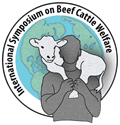Heat Stress in Feedlots
Keep cattle alive by combatting heat stress
MANHATTAN, Kan. (May 20, 2010) — "Cattle don’t get hot and die; they get hot and then die the next day," said Dee Griffin, professor at the University of Nebraska Veterinary and Biomedical Science Department. Speaking at the International Symposium on Beef Cattle Welfare, Griffin explained several factors involved with heat stress in cattle.

Recognize high-risk groups and symptoms of heat stress early, Dee Griffin recommends.
Heat stress occurs when the heat load is greater than what the animal can dissipate, Griffin noted. There are three different types of susceptibility factors to heat stress:
• Inherent factors, including hair color and genetics;
• transient factors, including age, acclimation, nutrition and health; and
• environmental factors, including temperature, humidity, wind speed and overnight low temperatures.
Low temperatures reached overnight are key to timing cattle processing, Griffin said. When trying to work cattle in the late evening, he realized the cattle were not getting cool enough and they were still having problems with heat stress and death. Working cattle of an evening may be cooler for those working, but the cattle core body temperatures are just peaking, he explained, adding that they now wait till 4 a.m. to begin processing on extremely hot days.
Griffen also advised feeding during evening hours so the heat caused by digestion will occur during the cooler evening hours.
The design of an operation can be play a role in how much the heat will stress an animal. Griffin advised putting tall mounds around the lot, explaining they can increase wind speeds by 3-5 miles per hour for cattle standing on top of them. Griffin encouraged getting rid of all windbreaks (unless winter weather is extreme) as they can block airflow during summer months.
Along with the welfare issues, heat stress can cause economic losses. A decrease in feed intake and increased susceptibility to diseases are two examples Griffin gave.
Recognize the high-risk groups and signs of heat stress early, Griffin advised. “Do what it takes to keep them comfortable.” Ask the local fire department to come out and spray the cattle with water to help them cool, he offered as an example. Steroids and IV fluids can also be used in extreme situations to save a life.
Editor’s Note: The articles used within this site represent a mixture of copyrights. If you would like to reprint or repost an article, you must first request permission of Angus Productions Inc. (API) by contacting the editor at 816-383-5200; 3201 Frederick Ave., Saint Joseph, MO 64506. API claims copyright to this web site as presented. We welcome educational venues and cattlemen to link to this site as a service to their audience.

